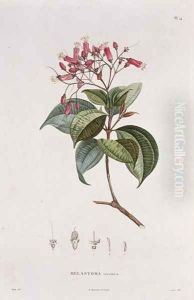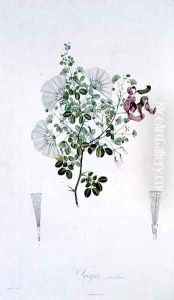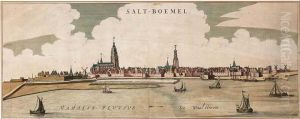





Rhexia stricta, engraved by Bouquet, plate 8 from Part VI of Voyage to Equinoctial Regions of the New Continent by Friedrich Alexander, Baron von Humboldt 1769-1859 and Aime Bonpland 1773-1858 pub. 1806
-
About Reproduction
Discover the allure of art with our faithful reproduction of "Rhexia stricta, engraved by Bouquet, plate 8 from Part VI of Voyage to Equinoctial Regions of the New Continent by Friedrich Alexander, Baron von Humboldt 1769-1859 and Aime Bonpland 1773-1858 pub. 1806", originally brought to life by the talented Pierre Jean Francois Turpin. Unlike posters or prints, our hand-painted oil painting breathes an unique sense of depth and texture into your space. Every detail, every stroke, and every texture is meticulously recreated, paying the perfect homage to Pierre Jean Francois Turpin and his artistic vision.
Owning this piece is more than just decoration - it's a statement of your refined taste in art. Let the vibrant colors and intricate details of this replica serve as a daily reminder of the beauty in our world. Elevate your decor and appreciate the richness of art with our replica of this masterpiece.
-
Painting Description
Rhexia stricta, as depicted in the exquisite engraving by Bouquet, is featured prominently as plate 8 in Part VI of the monumental work "Voyage to the Equinoctial Regions of the New Continent." This extensive scientific and exploratory publication was authored by the renowned naturalists Friedrich Alexander, Baron von Humboldt (1769-1859), and Aimé Bonpland (1773-1858), and was published in 1806. The engraving itself was executed by Pierre Jean François Turpin, a distinguished botanical illustrator of the period, whose meticulous attention to detail and artistic skill brought the botanical subjects to life with remarkable accuracy and aesthetic appeal.
"Voyage to the Equinoctial Regions of the New Continent" is a seminal work that documents the extensive travels and scientific observations made by Humboldt and Bonpland during their expedition to the Americas from 1799 to 1804. This journey, which covered vast and diverse regions including present-day Venezuela, Colombia, Ecuador, Peru, Cuba, and Mexico, was pivotal in the development of several scientific fields, including botany, geography, and ecology. The publication is celebrated not only for its scientific contributions but also for its rich illustrations, which provided European audiences with some of the first visual representations of the exotic flora and fauna of the New World.
Rhexia stricta, a species within the Melastomataceae family, is one of the many botanical specimens meticulously documented in this work. The engraving by Bouquet captures the intricate details of the plant, showcasing its distinctive features such as the structure of its leaves, flowers, and stems. Turpin's engraving serves as both a scientific record and an artistic masterpiece, reflecting the Enlightenment-era emphasis on the union of art and science.
The inclusion of Rhexia stricta in Humboldt and Bonpland's publication underscores the importance of botanical exploration during this period and highlights the contributions of these pioneering naturalists to our understanding of the natural world. Their work laid the groundwork for future scientific inquiry and remains a cornerstone in the history of botanical illustration and exploration.
-
Lead Time & Shipping
When you order this oil painting replica, it typically takes 2-3 weeks to paint. If the artwork is more complex, it might need a little more time to ensure the best quality. Once it's ready, we'll send you a photo for your approval. After you give the green light, we'll ship it to you for free.
-
Return & Refund
We believe in the quality of our hand-painted oil painting reproductions, and your satisfaction is our priority. If for any reason, you are not completely satisfied with your purchase, we offer a 45-day return policy. You can return your artwork within 45 days of receipt and receive a full refund. Please note that the artwork must be returned in the original packaging and in the same condition as it was received.




















